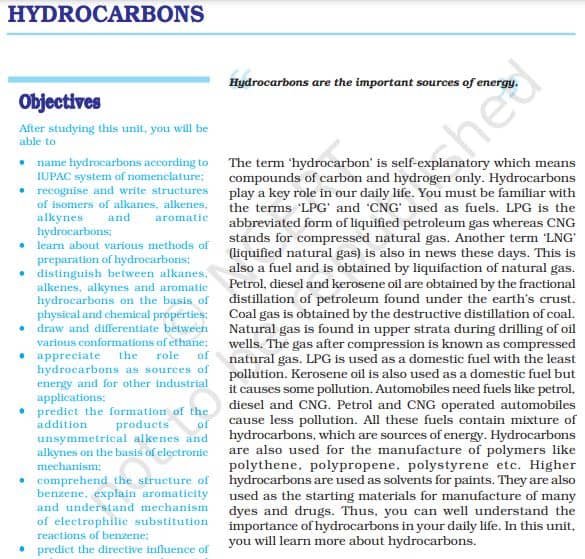‘Hydrocarbon Class 11’ PDF Quick download link is given at the bottom of this article. You can see the PDF demo, size of the PDF, page numbers, and direct download Free PDF of ‘Hydrocarbon NCRT’ using the download button.
Hydrocarbon Class 11 Textbook PDF Free Download

Detail Explanation About Hydrocabon With Example
The term ‘hydrocarbon’ is self-explanatory which means compounds of carbon and hydrogen only. Hydrocarbons play a key role in our daily life.
You must be familiar with the terms ‘LPG’ and ‘CNG’ used as fuels. LPG is the abbreviated form of liquified petroleum gas whereas CNG stands for compressed natural gas.
Another term ‘LNG’ (liquified natural gas) is also in news these days.
This is also a fuel and is obtained by the liquefaction of natural gas. Petrol, diesel, and kerosene oil are obtained by the fractional distillation of petroleum found under the earth’s crust.
Coal gas is obtained by the destructive distillation of coal.
Natural gas is found in the upper strata during the drilling of oil wells. The gas after compression is known as compressed natural gas.
LPG is used as a domestic fuel with the least pollution. Kerosene oil is also used as a domestic fuel but it causes some pollution.
Automobiles need fuels like petrol, diesel, and CNG. Petrol and CNG-operated automobiles cause less pollution. All these fuels contain a mixture of hydrocarbons, which are sources of energy.
Hydrocarbons are also used for the manufacture of polymers like polythene, polypropene, polystyrene, etc. Higher hydrocarbons are used as solvents for paints.
They are also used as the starting materials for the manufacture of many dyes and drugs.
Thus, you can well understand the importance of hydrocarbons in your daily life. In this unit. you will learn more about hydrocarbons.
Classification Of Hydocarbon
Hydrocarbons are of different types. Depending upon the types of carbon-carbon bonds present, they can be classified into three main categories –
(i) saturated (11) unsaturated and (111) aromatic hydrocarbons.
Saturated hydrocarbons contain carbon-carbon and carbon-hydrogen single bonds.
If different carbon atoms are joined together to form an open chain of carbon atoms with single bonds, they are termed as alkanes as you have already studied in Unit 12.
On the other hand, if carbon atoms form a closed chain or a ring, they are termed cycloalkanes.
Unsaturated hydrocarbons contain carbon-carbon multiple bonds double bonds, triple bonds or bot Aromatic hydrocarbons are a special type of cyclic compounds.
You can construct a large number of models of such molecules of both types (open chain and close chain) keeping in mind that carbon is tetravalent and hydrogen is monovalent.
For making models of alkanes, you can use toothpicks for bonds and plasticine balls for atoms. For alkenes, alkynes, and aromatic hydrocarbons, spring models can be constructed.
Alkanes
As already mentioned, alkanes are saturated open-chain hydrocarbons containing carbon single bonds. Methane (CH₂) is the first member of this family. Methane is a gas found in coal mines and marshy places.
If you replace one hydrogen atom of methane by carbon and join the required number of hydrogens to satisfy the tetravalence of the other carbon atom, what do you get? You get C2H6. This hydrocarbon with molecular formula C2H6 is known as ethane.
Thus you can consider C2H6 as derived from CH4 by replacing one hydrogen atom with -CH3 group.
Go on constructing alkanes by doing this theoretical exercise i.e., replacing a hydrogen atom with –CH3 group. The next molecules will be C3H8, C4H10 …
Preparation Of Hydrocarbon
Petroleum and natural gas are the main sources of alkanes. However, alkanes can be prepared by following methods :
From unsaturated hydrocarbons
Dihydrogen gas adds to alkenes and alkynes in the presence of finely divided catalysts like platinum, palladium, or nickel to form alkanes.
This process is called hydrogenation. These metals adsorb dihydrogen gas on their surfaces and activate the hydrogen–hydrogen bond.
Platinum and palladium catalyze the reaction at room temperature but relatively higher temperature and pressure are required with nickel catalysts.
| Author | NCERT |
| Language | English |
| No. of Pages | 33 |
| PDF Size | 3 MB |
| Category | Education |
Related PDFs
Carbon And Its Compounds Class 10 PDF
Work Power And Energy Class 9 NCERT PDF
Hydrocarbon Class 11 PDF Free Download
